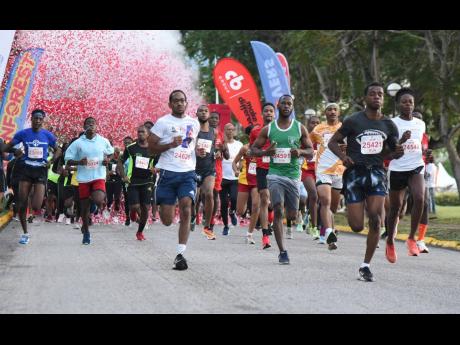From barbecue fun days to running 5Ks
IN THE recent past, fish fries, bake sales, and school barbecue fun days were fundraisers of choice for schools, churches, civic organisations, and charitable bodies. Costly, exclusive fundraising galas and cocktail parties worked for corporate bodies. As awareness about healthy lifestyle choices have gained traction, one has seen a paradigm shift in national policy and personal practices. Plates of food and branded drinks have been exchanged for feet pounding the pavement for charity, water or sport drink in hand. A prime example of the shift in thinking from ‘eat now and cure later’ to ‘train now and live longer’, is the Jamaica Moves campaign implemented by the Ministry of Health and Wellness.
THE ECONOMICS OF FITNESS EVENTS
These days, pound for pound, calorie for calorie, dollar spent for dollar raised, a well-planned fitness event will TKO a food event at fundraising. The sports tourism industry in the USA is estimated to be worth US$6 billion annually. In 2014, the city of San Diego alone hosted 134,000 guests in 66 fitness events and raised US$64.1 million.
From March 29, 1981 to 2018, the London Marathon raised £1.1 billion, and according to tcslondon.com, the 2023 edition alone raised £63 million.
In April 2018, The Gleaner stated that the Guardian Group Foundation’s annual ‘Keep it Alive’ event, between 2014 and 2018, raised J$57 million for the health sector. In 2019, the target set was J$35 million. The ever popular Reggae Marathon has, since inception, infused an estimated US$11 million into the economy, according to the Reggae Marathon website.
While a UWI study done in 2014 predicted a buoyant market for fitness events, I have noted that pleas to buy harvest supper, fish fry, and barbecue tickets are rare these days.
BENEFITS OF FITNESS EVENTS
Individual training for, and participation in, fitness events improves mental and physical health, weight management, and musculoskeletal conditioning. It also reduces risks of non-communicable, lifestyle-related illnesses, and premature death or disability. In the short term, focus, memory, and problem-solving skills also show improvement.
For corporate bodies, sponsorship of fitness events, such as 5Ks, have been known to boost company and employee morale and public perception of the corporations. Sponsorship also encourages the stakeholders at all levels of the organisation to adopt healthier lifestyles for better health outcomes.
With the plethora of options now available for advertising, registration, and participation, brand recognition is now possible in more places than ever before.
THE APPEAL OF 5K RUN/WALKS
In terms of safety, wider participation, preparation and accessibility, 5Ks are a favourite. Preparation for a 5K event may take as little as two weeks, with regular runners taking 28-37 minutes, and brisk walkers about 60 minutes per session thrice per week. Tailored, safety-conscious, training programmes online also minimise the need for specialised coaching. Affordable equipment and adaptability to different settings are pluses.
Participants can now be part of global networks such as Parkrun, a United States Track and Field initiative, which offers online publication of free, timed, age-graded running to about 350,000 people from 22 countries each Saturday morning.
COMMON RUNNING INJURIES
Run/walk events are not without injuries.
Jumper’s knee(s) and hamstring pain each affect about 12 per cent of runners. Policeman’s heel, with pain across the arches of the feet, affect about 18 per cent. Shin splints and iliotibial band syndrome, affecting the outer aspect of the thigh, are also fairly common injuries.
PREVENTION
To reduce injuries, participants should select proper clothing, socks, footwear, and training surfaces. One should practise warm-up, stretching before and after sessions, and cool-down routines. Changes to one’s routine must be gradual as one’s fitness improves. Proper hydration is key and a carefully planned running strategy should be used for events.
COLLAPSES
Benign or serious participant collapse and sudden cardiac deaths are major concerns for organisers.
Benign causes include exhaustion, dehydration, muscle cramps, and postural falls in blood pressure. Serious causes include low blood sodium or blood sugar levels, heat- or cold-related illnesses, life-threatening irregular heartbeats, muscle breakdown, and exposure to toxins.
Parkrun events mandate that all clinical encounters and non-finishers be reported, and that an automatic external defibrillator (AED) be present at all races.
Coming out of St Mary’s University in the United Kingdom, data collected by Parkrun in the UK between 2014 and 2019 and published in a British Journal of Sports Medicine article showed that of two million participants with 29 million finishes, there were 18 deaths reported. That works out to 0.00009 deaths/million participants. Of 84 life-threatening events reported, there were strokes, cases of respiratory failure, a spinal injury, and 73 cardiac cases. Cardiac cases included cardiac arrests, acute coronary syndrome events, and bouts of serious irregular heartbeats.
The USA National Library on Medicine cites the overall incidence of death in long road races to be 3.1 per million finishers, with 5K and 10K events the safest. Triathlons have the highest mortality rate due to more cardiac events and drownings.
In Jamaica we have no such data base, but we do have fatalities from time to time.
MITIGATING THE RISKS
Pre-participation screenings by a sports/exercise medicine physician is one of the best ways to mitigate the risks of injury and death. South Africa also instituted online pre-participation tools and public education for their Two Oceans half-marathon and ultra-marathon and saw a 29 per cent fall in medical encounters and a dramatic fall in the incidence of life-threatening events.
According to The USA National Library on Medicine, the final mile in a marathon is less than five per cent of the total distance, but accounts for 50 per cent of sudden cardiac deaths at these events. For Parkrun events, there was a 65 per cent survival rate for cardiac arrests, as opposed to a 10 per cent survival rate for such tragedies occurring outside of hospitals in the general population. Mandatory AEDs at every Parkrun event was cited as the reason for the better survival rate.
Like so many of life’s better choices, participation in fitness events is not without risk.
When walking, jogging, running, cycling, swimming or wheelchairing in fitness events, do it safely, help raise money for charity, and have fun.


